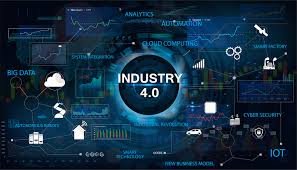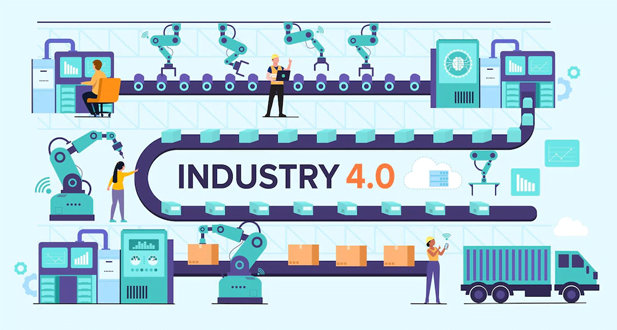About
Industry 4.0 is the term used to describe the fourth industrial revolution, which is the current trend of automation and data exchange in manufacturing technologies. It is the smart factory concept, where cyber-physical systems monitor physical processes and make decentralized decisions. It involves technologies such as the Internet of Things (IoT), artificial intelligence (AI), cloud computing, augmented reality (AR), robotics, and 3D printing. The goal of Industry 4.0 is to create smart factories that are connected, flexible, and responsive to customer needs.
Industry 4.0 is the fourth industrial revolution. It is the name given to the trend of automation and data exchange in manufacturing technologies. It covers cloud computing, cognitive computing, cyber-physical systems, and the Internet of Things. A “smart factory” is what is produced by industry 4.0. Cyber-physical systems control physical processes, simulate the real world, and make decentralized choices inside modularly designed smart factories. Cyber-physical systems may interact and work together with humans in real-time over the Internet of Things, and value chain players can offer and use both internal and cross-organizational services through the Internet of Services.
Industry 4.0 promises to increase efficiency and productivity by using data-driven insights and automation. It will also improve the safety and quality of products, reduce waste and lead times, and enable greater customization of products. In addition, it will provide new business models and opportunities for new products and services.
Advanced sensors, embedded software, and robots are all featured in these “smart factories,” which gather and analyze data to help with decision-making. When operational data from ERP, distribution networks, customer service, and other corporate systems is linked with data from manufacturing processes, even greater value from previously segregated information is produced.
Increased automation, maintenance scheduling, self-optimization of process improvements, and, most importantly, a new level of efficiency and customer responsiveness made possible by digital technology are all results of their use.
The manufacturing sector has a fantastic potential to join the fourth industrial age by developing smart factories. Real-time awareness of manufacturing assets is ensured by analyzing the massive volumes of big data gathered from sensors just on the factory floor. This analysis can also give tools for doing predictive maintenance to reduce equipment downtime.
Smart factories using IoT technology provide increased production and better quality. Manufacturing mistakes are decreased, and money and time are saved when manual inspection business models are replaced with AI-powered visual insights. A smartphone connected to a cloud may be easily set up by quality control workers to enable remote monitoring of production operations. Manufacturers may identify mistakes earlier rather than later, when restoration work is more expensive, by using machine learning algorithms.
Background information on Industry 4.0
- First industrial revolution
The first industrial revolution, which began in Britain in the late 18th century, made mass manufacturing possible by substituting water and steam power for just human and animal power. Instead of being meticulously produced by hand, finished things were manufactured by machines.
- Second Industrial Revolution
Assembly lines and the utilization of gas, oil, and electricity were all introduced during the second industrial revolution, which occurred a century later. With the introduction of these new power sources and more sophisticated telephone and telegraph communications, industrial processes began to be automated and mass-produced.
- Third Industrial Revolution
The third industrial revolution, which started in the middle of the 20th century, improved production processes by incorporating computers, modern telecommunications, and data analysis. Programmable logic controllers (PLCs), which were used to automate some operations and gather and exchange data, were incorporated into machinery as the first step in the digitalization of industries.
- Fourth industrious revolution
The 4th industrial revolution, commonly known as Industry 4.0, is now underway. With the use of smart equipment and factories, informed data enables the production of goods to be more productive and efficient across the value chain. Increased flexibility enables producers to use mass customization to better satisfy client requests, eventually aiming to maximize efficiency with, in many circumstances, a lot size of one.
Industry 4.0 stages
- The first stage of maturity
In each industry that is undergoing a digital change, or revolution, if you prefer, we observe precisely the same thing. As firms go from more or less evident aims to actual innovation and even disruption, it represents that initial step in a larger ecosystem of possibilities. Beyond the boost productivity factor, the Boston Consulting Group’s picture below highlights some elements of this larger ecosystem of possibilities.
The majority of manufacturing or industrial companies are still in the stage where they have the desire to transform and are making isolated efforts, but there is frequently a lack of a bigger picture, a more comprehensive program, or as the Boston Consultancy Firm refers to it in the context of Industry 4.0, a broader strategy.
The focus on the previously described optimization & automation goals and advantages is also present at this point of maturity, which is very acceptable but shouldn’t be the end of it.
This is absolutely comparable to IDC’s findings about the slow transition from the Internet of Things pilot programs to larger-scale deployments, where IDC discovered that the advantages sought from these deployments are mostly focused on internal objectives and operations.
Due to the fact that internal objectives are crucial and that the Internet of Things is viewed more as strategy and tactics than transformative, despite the rise in huge IoT initiatives, this position is likely to persist for some time.
- The next maturity stages
Not for the purpose of maturity, but in order to go through that higher productivity toward greater agility, possibilities that arise in real-time, the growth of an inventive capability, and actual innovation,
Again, the solutions and difficulties are universal to all digital revolutions. It takes more than projects and productivity to create competitive services and benefits that can have a significant impact on the business model as well as the industry as a whole, develop new competencies, and identify new opportunities inside the equation of intellect, people, processes, and innovation.
According to at least one observer, even 10 years after the “launch” of Industry 4.0, most businesses are still very early in their efforts to combine the physical and digital worlds.
Industry 4.0 technologies
- Analytics using big data and AI: In Industry 4.0,
Big Data is gathered from various sources, including Internet of Everything (IoT) gadgets and manufacturing equipment, ERP and CRM systems, weather and traffic applications, and more. In order to improve decision-making & automation in every aspect of supply chain management, including supply chain management, logistics management, manufacturing, R&D & engineering, enterprise asset management (EAM), & procurement, analytics powered by artificial intelligence (AI) as well as machine learning are applied to a data in real-time.
Vertical and horizontal integration
Integrating vertically and horizontally is the foundation of Industry 4.0. The “field level” of horizontal integration refers to the factory floor, various production facilities, and the whole supply chain, where operations are tightly connected. Data may readily flow from the shop floor to the top level and back again thanks to vertical integration, which connects all the organizational layers. In other words, data and information silos are no longer an issue since manufacturing is intimately connected with corporate activities like R&D, quality assurance, marketing and sales, and other departments.
- Internet of Things:
The “great enabler” of Industry 4.0 and digital transformation is cloud computing. Modern cloud computing offers many benefits in addition to scalability, efficiency, and speed. It lays the groundwork for the most cutting-edge technologies, from artificial intelligence and machine learning to the Internet of Things, and it offers companies the tools to innovate. The cyber-physical systems just at the center of Industry 4.0 use the cloud for communication and coordination, and the data that powers these technologies is stored there.
- A.R. (augmented reality)
Industry 4.0’s central idea is augmented reality, which superimposes digital material in a real-world setting. When using an AR system, workers gaze at a physical object, such as a piece of machinery or a product, and may view real-time IoT data, digitized components, repair and assembly instructions, training information, and more.
- Internet of Things for Industry:
Industry 4.0 places such a strong emphasis on Industry 4.0 that the names are sometimes used interchangeably. In Industry 4.0, the majority of physical objects—devices, robots, machinery, equipment, and products—use sensors and RFID tags to transmit real-time information about their state, functionality, or location. This technology enables businesses to create quickly and operate more efficient supply networks.
- 3D printing and additive manufacturing
Another significant technology powering Industry 4.0 is additive manufacturing, sometimes known as 3D printing. Originally used for quick prototyping, 3D printing today has a wide range of uses, including mass customization and dispersed production. For instance, using 3D printing, items and components may be kept in virtual inventories as design files and printed as needed, cutting down on travel expenses and distance.
- Autonomous machines
A younger breed of autonomous drones is coming with Industry 4.0. Autonomous robots, which are designed to carry out activities with little to no human assistance, come in a wide range of shapes and sizes, from inventory scanning drones to mobile autonomous robots used in pick-and-place operations.
- Digital twins/simulation:
Based on IoT sensor data, a digital twin is indeed a virtual replica of a real-world machine, item, process, or system. This essential element of Industry 4.0 enables companies to comprehend, evaluate, and enhance the functionality and upkeep of production plants and goods. A digital twin, for instance, may be used by an asset operator to pinpoint a specific faulty component, foresee foreseeable problems, and increase uptime.
- Cybersecurity:
Effective cybersecurity is crucial given Industry 4.0’s growing connection and usage of Big Data. Companies may automate threat intelligence, prevention, and response – and reduce the risk of data breaches & production delays across their networks – by deploying a Zero Trust architecture with technologies like computer vision & blockchain.
Advantages of Industry 4.0
Earlier in this review, we covered a few advantages, hazards, and problems. Now, let’s take a deeper look at some of the primary advantages. Other pages on this site go into further detail about a few of them as well.
Industry 4.0’s primary objective is to accelerate the pace of production and allied sectors like logistics while identifying new business prospects and models by moving beyond automation and efficiency.
The majority of the advantages of Industry 4.0 are, clearly, comparable to those of the Industrial Internet, the digital transformation of manufacturing, operational & business optimization, information-powered ecosystems of value, and many other subjects covered on our website.
- Improved productivity achieved by automation and optimization
Process and productivity optimization is the first advantage that manufacturers notice, as was noted in the section just on the state of Industry 4.0.
It’s also one of its initial objectives of initiatives for Industry 4.0. Or, to put it another way: lowering costs, boosting profits, cutting waste, automating to avoid mistakes and delays, accelerating production to operate more in real-time and also in function of the entire value chain, where speed is essential for everyone, digitizing paper-based flows, being able to act more quickly in the event of production issues, and so on.
It’s an easy but significant target. The evidence that investments are made in these areas initially is apparent, in addition to the studies from BCG that we previously highlighted. Once more, it’s not a surprise that manufacturing processes are the top use case for manufacturers to invest their Internet of Things (IoT) money.
- Real-time data for just a real-time economy and supply chain
Even though we just emphasized speed in terms of optimization, automation, and increased production, it has many more advantages.
The advantages of increased productivity often revolve more around internal objectives like cost reduction and process improvement. However, many of them also fall under the umbrella of improved client-centricity.
Manufacturing certainly doesn’t stand on its own, and Industry 4.0 is about the complete life cycle. There are several stakeholders if you consider the complete value chain & ecosystem that manufacturing activities are a part of. All of these are clients. Customers, no matter where they are in the supply chain, likewise desire increased productivity.
- Improved business continuity with more sophisticated maintenance and monitoring options
An industrial asset has to be repaired when it breaks. That takes time, money, and frequently a lot of movement by engineers and support staff.
When a crucial industrial asset fails, like an industrial robot at a company that makes cars, more than just the robot is damaged. Production is impacted, which results in significant financial loss and dissatisfied consumers, and production disruptions can occasionally occur completely. Everyone dreads it since company continuity is such a major worry.
In addition to all the replacement and repair labor, expenses, and expenditures, reputation can be ruined, orders can be canceled, and money is lost every hour that passes. The advantages are enormous if industrial assets are connected, can be monitored (personal health monitoring, for example), and problems are addressed before they ever arise. Setup of alerts, proactive asset maintenance, real-time monitoring and diagnostics, remote issue repair by engineers, and a host of other benefits are all conceivable. Additionally, trends and insights are discovered to optimize in areas where problems appear to occur more frequently, and as we’ll see, a world of additional maintenance services emerges.
- Improved conditions for employees and sustainability
The human (& social) factor is pervasive in Industry 4.0 when it comes to humans. Additionally, if we consider the advantages and potential, the human, societal, and even sustainability aspects are crucial to achieving Industry 4.0’s objectives.
Better collaboration and communication options, a focus on ergonomic principles, clean air & clean factory initiatives, real-time temperature, humidity, and other data in the plant as well as warehouse, quick incident detection and enhanced protection, and detection of the presence of gasses, radiation, and other things.
Along with above mentioned rapid answers and timely information/delivery, people have also grown more demanding. Additionally, customers value some customization, depending on the situation. Think about athletic footwear. We know we want the flexibility to personalize them whatever we want when once a few colors of the same footwear were adequate.
Additionally, a different phenomena is present and it disturbs conventional supply networks. Customers have more opportunities to communicate directly with brands and their production capacity (and they desire these opportunities). Digital platforms for product customization, such as those already stated, faster delivery times, co-creation options, etc. Many production settings already have these items in place.
Conclusion
Industry 4.0 is a new era of industrial transformation that is becoming increasingly important for businesses to remain competitive in the global marketplace. It promises to revolutionize the way companies operate, by creating a fully connected and automated industrial ecosystem. Industry 4.0 is characterized by the use of technologies such as the Internet of Things, autonomous systems, artificial intelligence, robotics, and cloud computing, to provide a more efficient, flexible, and cost-effective production model. It has the potential to create a new and more efficient way of doing business, and it is an exciting opportunity for businesses to take advantage of.
Frequently Asked Questions
The benefits of Industry 4.0 include increased efficiency, improved quality, faster production times, greater customization, lower costs, improved safety, and better sustainability. Additionally, Industry 4.0 will enable manufacturers
Industry 4.0 will revolutionize the manufacturing industry by introducing new technologies such as the Internet of Things (IoT), artificial intelligence (AI), robotics, and 3D printing. These technologies will enable manufacturers to reduce costs, improve the speed and quality of production, and create products that are customized to individual customer needs.
The impact of Industry 4.0 will alter how people live, think, work, and interact with the world around them. Artificial intelligence is one of the key elements of industry 4.0. (AI).
Increased revenue & profitability: Industrial revolution 4.0 not only improves the quality and efficiency of the production process but also makes upgrades and preventative maintenance possible, reducing downtime and requiring less capital investment over time.
Industry 4.0 broadly refers to the industrial sector’s expanding tendency toward automation and data interchange in technologies and processes, including: the “Internet of Things” (IoT) the Internet of Things in industry (IIoT) digital and physical systems (CPS)
The mainstreaming of responsive and flexible education is being facilitated by technological advancements.




